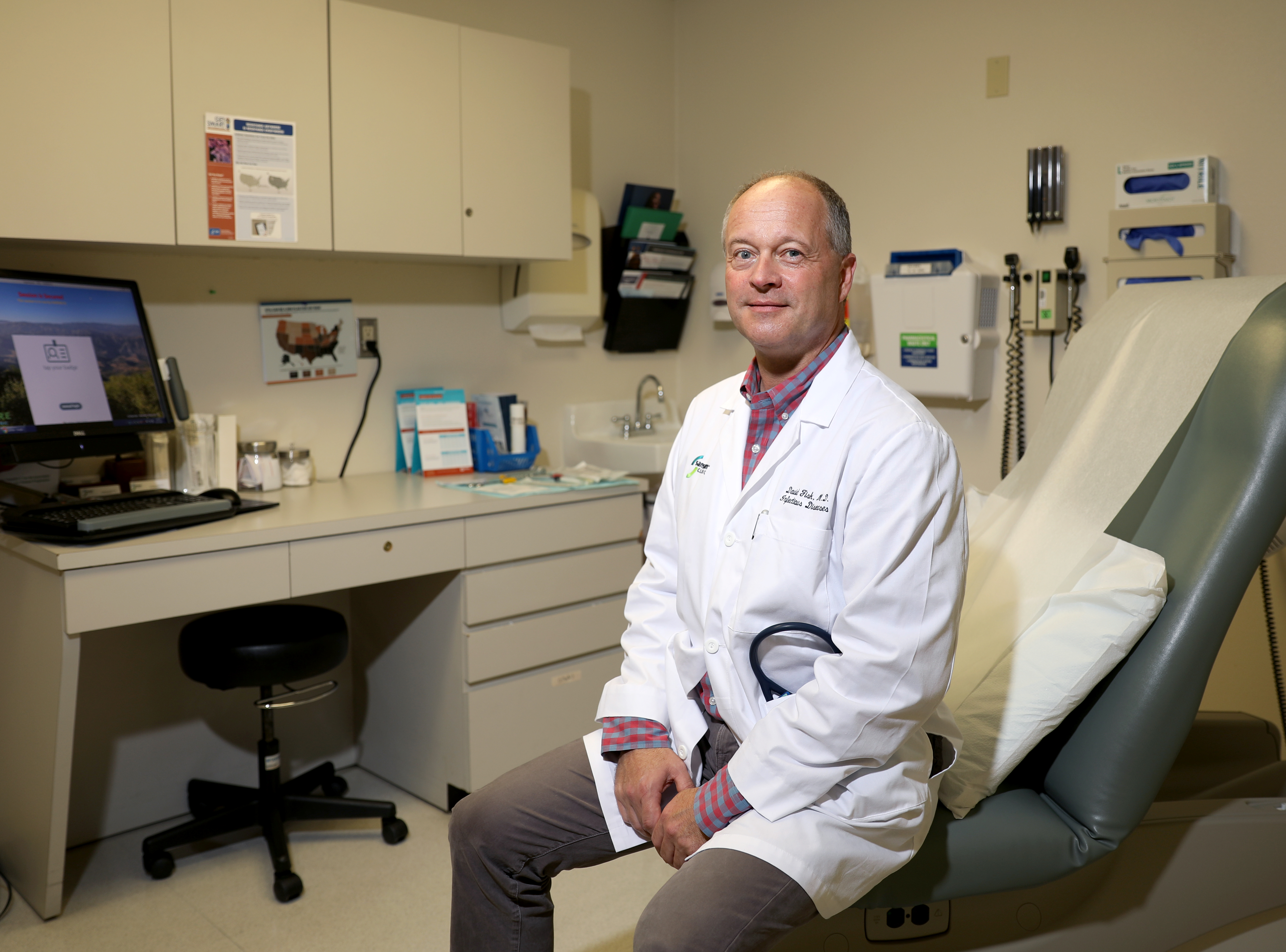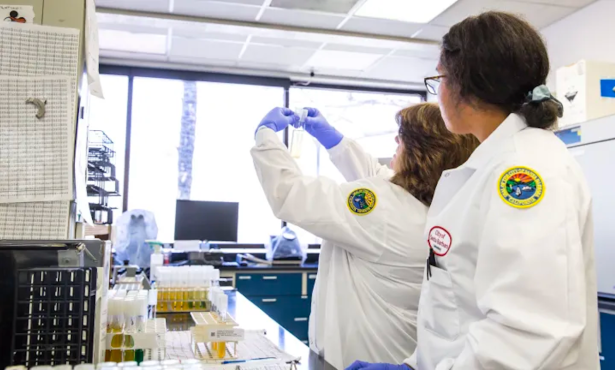Santa Barbara Will ‘Likely’ See COVID Spike in Coming Months, Says Infectious Disease Specialist
Dr. David Fisk Offers Insights into Therapies and the Best Defense Against Virus

If it weren’t for the fever and cough breaking out in parts of the county, the busy streets and highways make it seem as if Santa Barbarans have put the worst of the coronavirus behind them. That’s what it looked like on the South Coast on October 5 when Cottage Health reported it had only two COVID-19 patients. Countywide, hospitalizations had steadily dropped from the 30s to the 20s, though they’ve risen in the past week.
We asked Dr. David Fisk, a Johns Hopkins–trained infectious disease specialist, about the county’s prognosis. Dr. Fisk is medical director for infection control at Cottage and a Sansum Clinic doctor, and he took time from his patient load to give us some insight into this new coronavirus, what the medical world has learned, and what they expect this winter.
Get the top stories in your inbox by signing up for our daily newsletter, Indy Today.
Any theories on why the South Coast case rate dropped? Was it the hotter summer weather?
I don’t think the hotter summer weather has played a significant role in the trends of COVID. Around the world, the warm-weather pattern has not reflected dramatically less spread. Studies show the virus is able to be transmitted as an airborne organism year-round, and it’s a little more effectively transferred when humidity rates are lower.
I think the main explanations for why the South Coast COVID rate has dropped are due to increases in testing and increased availability of testing. This allows us to identify people earlier, and they can therefore be isolated if they have COVID. This is essential to reducing the spread of the virus.
Also, people have taken seriously the guidance of masks and distancing. People are wearing masks, avoiding gatherings, and washing their hands more than ever. It helps protect our community.
However, it’s likely the drop in COVID patients that we’re seeing in our region is temporary, and numbers will go back up in coming months. We’re seeing very, very concerning trends in the Midwest and other parts of the United States. They’re seeing all-time record highs in the number of cases, and hospitals are at or over capacity in some communities. Test positivity rates are as high as one in four people tested in states like Wisconsin.
What have you learned about treating coronavirus since the first patients were diagnosed in April?
We’ve learned more about how the virus behaves. We’ve quickly grown our expertise in COVID care and also in providing it in a way that is safe for our staff and for patients whose hospitalization is unrelated to COVID. As an organization, Cottage has learned how to adapt quickly to changing patient census and to build, construct, staff, and activate new care units when they’re needed.
Can you tell us about the drugs, steroids, antibody serums, and other therapies we’ve all heard about?
Treatment options continue to evolve as we learn more about the virus and review research. Each patient’s acuity, symptoms, and comorbidity considerations are different. They require evaluation for individualized care and a careful look at potential benefits and risks in each treatment option. Timing of the treatment is also a factor.
We’ve seen positive outcomes in patients who have been treated with dexamethasone [a steroid] and with remdesivir [a virus inhibitor]. We’ve observed that a combination of interferons [proteins released by the body in response to a virus] and ribavirin [an anti-viral agent] may provide benefits early in the course of treatment. We’re also studying the effectiveness of convalescent plasma [blood plasma containing antibodies from individuals who have recovered from COVID-19].
The knowledge is evolving as we collect more scientific data and we continue to adapt, so what we are doing months from now may look different.
Prevention — precautions to stop the spread of the virus — remains our best defense. Once people are hospitalized, we’re dealing with a very serious illness.
Are the treatments scarce or hard to get?
Right now, none of the treatments we’re using are in scarcity mode. Medications we’re using now that were previously scarce have evolved to a point where hospitals can purchase them through our regular channels. Convalescent plasma does have some limitations on supply, but in general, when we’ve wanted to use it, we’ve been able to get it.
The president was given an experimental antibody therapy from Regeneron. Is that available to hospitals in California?
Experimental drugs typically require entry into a clinical trial, and not all hospitals are enrolled in this trial. It’s an early Phase 2 drug and was given to fewer than 200 people in the Phase 1 clinical trial. But the technology reflected in this monoclonal antibody is a concept of therapy that may have significant potential.
Cottage Health has a robust Research Institute and an Institutional Review Board to review research protocols and protect patients. While we are not part of this clinical trial, we have participated in other clinical research related to COVID and continue to seek new opportunities for clinical study. Not every hospital throughout the state is equipped to do this level of research.
If masks have helped lower infections, will the flu season be less severe if people continue to wear them?
We now have quite good data showing that masks reduce the spread of COVID when worn by community members. We don’t yet have comparable data on the spread of influenza and wearing masks outside of health-care settings. A flu vaccine will offer the best protection and is especially important this year so we don’t find our community battling flu and COVID at the same time.
The hope for a mild flu season is largely based on information we’re seeing in the Southern Hemisphere, which is already undergoing its flu season. The numbers from South Africa and Australia have been favorable, but we also think physical distancing is playing a major role in reducing the spread of flu.
Flu remains a very lethal illness, killing 30,000 and sometimes 50,000 in a typical year in the United States. The highest-risk group for deaths from influenza are pregnant women, people with severe obesity, and the elderly.
What are doctors preparing for once businesses and schools open up, or the holidays?
The situation remains that COVID is present and active in our community. It is easily transmitted from person to person, and it spreads as an airborne infection. The more our community businesses and schools open up, unfortunately and unavoidably, we’re going to see more COVID. So we have to be aware of that and practice measures to protect ourselves and our loved ones.
What are your recommendations to make it through the winter safely?
One, get your influenza vaccine. The vaccine is for everyone over the age of six months.
Two, continue to wear a mask when you are outside your immediate household and indoors; wear a mask when less than six feet from other people, including in an outdoor setting.
Three, continue the protective measures that we’ve developed in our community over the last several months. This includes avoiding large group social gatherings — even with extended family and friends — where we know many people can be infected from one person. Staying within your household is the safest practice.
If you begin to feel sick with cold, flu, or COVID symptoms, stay home and call your health-care provider.
Every day, the staff of the Santa Barbara Independent works hard to sort out truth from rumor and keep you informed of what’s happening across the entire Santa Barbara community. Now there’s a way to directly enable these efforts. Support the Independent by making a direct contribution or with a subscription to Indy+.


